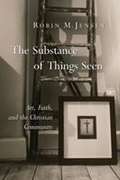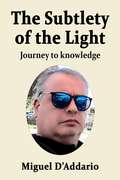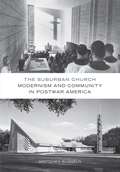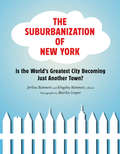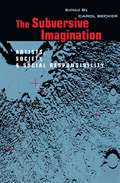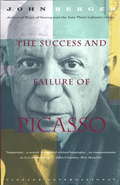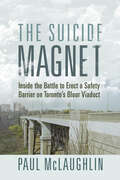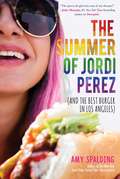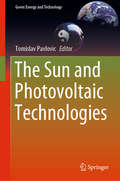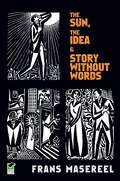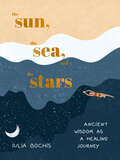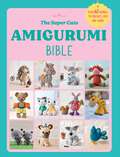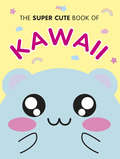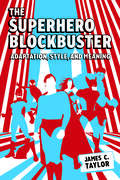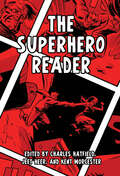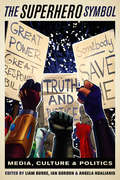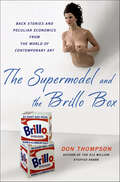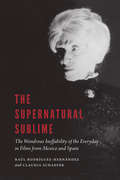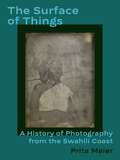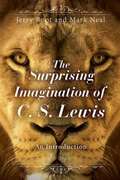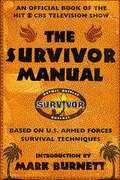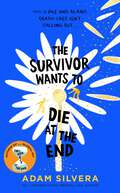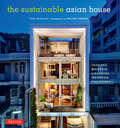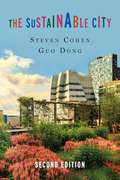- Table View
- List View
The Substance of Things Seen: Art, Faith, and the Christian Community (Calvin Institute of Christian Worship Liturgical Studies)
by Robin JensenWhile the average person rarely sees it, the visual arts play a subtle yet profound role in the teaching and formation of faith, both for individuals and religious communities. The Substance of Things Seen explores the intersection of art and faith, offering thoughtful reflections on the way art functions in Christian life and practice. <p><p> Highly readable and featuring instructive illustrations, this book is meant to engage church leaders as well as artists in constructive conversation about the critical role that art can play in the renewal of Christian education, worship, and study. It also challenges anyone who thinks the arts are only of marginal importance to the religious life. Robin Jensen considers here a broad range of topics relevant to Christian faith and culture, including the construction of sacred space, the use of art in worship and spiritual formation, the way that visual art interprets sacred texts, and the power and danger of art from a historical and contemporary perspective.
The Subtlety of the Light: Journey to knowledge
by Miguel D'AddarioThe Subtlety of the Light is a book that summarizes a number of writings related to philosophical, altruistic, metaphysical and existentialist thoughts. It is approached through poetic forms, essays or profound testaments. Based on schools of existential knowledge and currents that analyze the presence of man on earth. To analyze and reflect, understand and conclude.
The Suburban Church: Modernism and Community in Postwar America (Architecture, Landscape and Amer Culture)
by Gretchen BuggelnAfter World War II, America&’s religious denominations spent billions on church architecture as they spread into the suburbs. In this richly illustrated history of midcentury modern churches in the Midwest, Gretchen Buggeln shows how architects and suburban congregations joined forces to work out a vision of how modernist churches might help reinvigorate Protestant worship and community. The result is a fascinating new perspective on postwar architecture, religion, and society.Drawing on the architectural record, church archives, and oral histories, The Suburban Church focuses on collaborations between architects Edward D. Dart, Edward A. Sövik, Charles E. Stade, and seventy-five congregations. By telling the stories behind their modernist churches, the book describes how the buildings both reflected and shaped developments in postwar religion—its ecumenism, optimism, and liturgical innovation, as well as its fears about staying relevant during a time of vast cultural, social, and demographic change.While many scholars have characterized these congregations as &“country club&” churches, The Suburban Church argues that most were earnest, well-intentioned religious communities caught between the desire to serve God and the demands of a suburban milieu in which serving middle-class families required most of their material and spiritual resources.
The Suburbanization of New York: Is the World's Greatest City Becoming Just Another Town?
by Jerilou Hammett Kingsley Hammett Martha CooperThe city that never sleeps also never stops changing. And while New Yorkers are renowned for their trendsetting, this thought-provoking book argues that New York City itself has become a follower rather than a leader. Once-distinctive streets and neighborhoods have become awash in generic stores, apartment boxes, and garish signs and billboards. Legendary neighborhoods (Little Italy, Hell's Kitchen, Harlem, the Lower East Side) have been smoothed over with cute monikers, remade for real-estate investment and for sale to the highest bidder.
The Subversive Imagination: The Artist, Society and Social Responsiblity
by Carol BeckerFirst Published in 1994. Routledge is an imprint of Taylor & Francis, an informa company.
The Success and Failure of Picasso (Vintage International)
by John BergerAt the height of his powers, Pablo Picasso was the artist as revolutionary, breaking through the niceties of form in order to mount a direct challenge to the values of his time. At the height of his fame, he was the artist as royalty: incalculably wealthy, universally idolized--and wholly isolated. In this stunning critical assessment, John Berger--one of this century's most insightful cultural historians--trains his penetrating gaze upon this most prodigious and enigmatic painter and on the Spanish landscape and very particular culture that shpaed his life and work. Writing with a novelist's sensuous evocation of character and detail, and drawing on an erudition that embraces history, politics, and art, Berger follows Picasso from his childhood in Malaga to the Blue Period and Cubism, from the creation of Guernica to the pained etchings of his final years. He gives us the full measure of Picasso's triumphs and an unsparing reckoning of their cost--in exile, in loneliness, and in a desolation that drove him, in his last works, into an old man's furious and desperate frenzy at the beauty of what he could no longer create.
The Suicide Magnet: Inside the Battle to Erect a Safety Barrier on Toronto’s Bloor Viaduct
by Paul McLaughlinThe inside story of the grassroots fight to have a suicide barrier erected on Toronto’s “bridge of death.”Most Torontonians have no idea their city once hosted the second most popular suicide magnet in North America, behind the Golden Gate Bridge. Since its completion in 1918, more than four hundred people jumped to their death from the Bloor Viaduct, which spans the cavernous Don Valley.That number might still be rising if not for the tireless efforts of a group of volunteers, led by two citizens, who fought City Hall for years to get a suicide barrier erected. Not only did they win, they saved numerous lives and brought to light valuable research on how barriers actually lower suicide numbers overall. The resulting barrier — The Luminous Veil — has been praised for its ingenious and inspiring design.The Suicide Magnet tells how the battle was won, and explores the ongoing efforts to help those suffering from mental health challenges.
The Summer of Jordi Perez (And the Best Burger in Los Angeles)
by Amy Spalding<p>Seventeen, fashion-obsessed, and gay, Abby Ives has always been content playing the sidekick in other people’s lives. While her friends and sister have plunged headfirst into the world of dating and romances, Abby’s been happy to focus on her plus-size style blog and her dreams of taking the fashion industry by storm. When she lands a great internship at her favorite boutique, she’s thrilled to take the first step toward her dream career. Then she falls for her fellow intern, Jordi Perez. Hard. And now she’s competing against the girl she’s kissing to win the coveted paid job at the end of the internship. <p>But really, nothing this summer is going as planned. She also unwittingly becomes friends with Jax, a lacrosseplaying bro-type who wants her help finding the best burger in Los Angeles, and she’s struggling to prove to her mother—the city’s celebrity health nut—that she’s perfectly content with who she is. <p>Just as Abby starts to feel like she’s no longer the sidekick in her own life, Jordi’s photography surprisingly puts her in the spotlight. Instead of feeling like she’s landed a starring role, Abby feels betrayed. Can Abby find a way to reconcile her positive yet private sense of self with the image others have of her?</p>
The Sun and Photovoltaic Technologies (Green Energy and Technology)
by Tomislav PavlovicThis book covers solar energy and the use of solar radiation in connection with lighting. It provides a detailed introduction to solar energy, photovoltaic (PV) solar energy conversion, and solar lighting technologies, while also discussing all of these elements in the context of the Balkan Peninsula. In the context of solar energy, the book covers a range of elements, from the structure of the sun, to PV solar plants. It subsequently addresses the status quo of solar technologies in Bulgaria, Serbia and the Republika Srpska and analyses the development of these technologies over the years, including their economic status, and how these aspects have shaped their current status. Undergraduate and graduate students, researchers and professionals, particularly those based in the Balkans, will find this book both informative and interesting.
The Sun, The Idea & Story Without Words: Three Graphic Novels
by David A. Beronä Frans MasereelRich in symbolism, these compelling graphic novels feature more than 200 starkly beautiful woodcut illustrations. The passionate, dynamic narratives include The Sun, a somber exploration of one man's struggle with destiny; The Idea, a depiction of the triumph of an artistic concept over attempts at its suppression; and Story Without Words, a tale of thwarted romance. <p><p> Belgian-born Frans Masereel illustrated the works of Tolstoy, Zola, and Oscar Wilde, but he made the greatest impact with his wordless novels. These three stories, dating from the early 1920s, reflect the German Expressionist revival of the art of the woodcut. Precursors to today's graphic novels, they also represent a centuries-old tradition of picture books for unschooled audiences. Masereel combines allegory and satire in his explorations of love, alienation, and artistic creation. Thomas Mann praised these striking Expressionistic images as "so compelling, so deeply felt, so rich in ideas, that one never tires of looking at them." <p> <i>Advisory: Bookshare has learned that this book offers only partial accessibility. We have kept it in the collection because it is useful for some of our members. To explore further access options with us, please contact us through the Book Quality link on the right sidebar. Benetech is actively working on projects to improve accessibility issues such as these.</i>
The Sun, the Sea, and the Stars: Ancient Wisdom as a Healing Journey
by Iulia BochisA beautiful visual representation of personal growth and healing based around striking affirmations, mantras, and ancient wisdom, from Lao Tzu to Rumi and beyondWhen it seems that you have been left behind, in a moment of stillness you might realize that the infinite stars, the restless sea, and the patient moon are all traveling along with you. In this beautiful collection, artist Iulia Bochis pairs visual storytelling with timeless wisdom to take you on a voyage of self-discovery through the seasons of life. Following a traveler as they face the changes of fall, the loneliness of winter, the hopeful nature of spring, and the happiness of summer, these pages capture the grief, transformation, healing, and growth we all experience on the journey toward self-love. Guided by Iulia&’s insightful words and punctuated with Zen proverbs and quotes from prominent thinkers from Lao Tzu to Rumi, this vibrantly illustrated book will inspire you to trust the process, find comfort in new beginnings, and reflect on the beauty and magic that exists in the world around you.
The Super Cute Amigurumi Bible
by Ebury PressThe biggest amigurumi book yet, with over 60 adorable animals to crochet, love and share – it’s the cat’s pyjamas!Grab your crochet hook and head to a cosy corner – it’s time to get stitching! Including everything from farmyard familiars to fantasy friends, this bumper book of 60 amigurumi patterns has something to make for everyone you know.Featuring straightforward, tried-and-tested instructions and a range of difficulties, this gorgeous book includes a project for every taste and ability.
The Super Cute Book of Kawaii
by Marceline SmithLive a bright, fun, rainbow-filled life with Kawaii!The Japanese word Kawaii means lovable or adorable. Welcoming a little kawaii into your life is like opening the window and letting a sparkling sunbeam in. Whenever you feel a little low turn to this squishy, padded-covered book.Find fun ideas to: make a cosy kawaii home; playful, confidence boosting styling and beauty tips; and recipes that will make your smile. This book includes 10 easy how-to projects to bring kawaii into your life.Here, you'll also find a host of very special kawaii mascots that will always be ready to give you a hug when you need one: The Octonauts, Smiling Bear, Hello Kitty, Gudetama, Molang, Ricemonsters, Miffy the Rabbit, the Moomins, Donutella, Unicorno, Moofia and Pusheen.Escape into the magical world of kawaii...
The Superhero Blockbuster: Adaptation, Style, and Meaning
by James C. TaylorThe Superhero Blockbuster: Adaptation, Style, and Meaning builds an innovative framework for analyzing one of the most prominent genres in twenty-first-century Hollywood. In combining theories of adaptation with close textual analysis, James C. Taylor provides a set of analytical tools with which to undertake nuanced exploration of superhero blockbusters’ meanings. This deep understanding of the films attends to historical, sociopolitical, and industrial contexts and also illuminates key ways in which the superhero genre has contributed to the development of the Hollywood blockbuster. Each chapter focuses on a different superhero or superhero team, covering some of the most popular superhero blockbusters based on DC and Marvel superheroes. The chapters cover different aspects of the films’ adaptive practices, exploring the adaptation of stylistic strategies, narrative models, and modes of seriality from superhero comic books, while being attentive to the ways in which the films engage with the wider networks of texts in various media that comprise a given superhero franchise. Chapter 1 looks back to the first superhero blockbuster, 1978’s Superman: The Movie, examining its cinematic re-envisioning of the quintessential superhero and role in establishing Hollywood’s emerging model of blockbuster filmmaking. Subsequent chapters analyze the twenty-first-century boom in superhero blockbusters and examine digital imaging and nostalgia in Spider-Man films, Marvel Studios’ adaptation of a shared universe model of seriality in the Marvel Cinematic Universe, and the use of alternate timeline narratives in X-Men films. The book concludes by turning its analytical toolkit to analysis of DC Studios’ cinematic universe, the DC Extended Universe.
The Superhero Reader
by Charles HatfieldWith contributions from Will Brooker, Jeffrey A. Brown, Scott Bukatman, John G. Cawelti, Peter Coogan, Jules Feiffer, Charles Hatfield, Henry Jenkins, Robert Jewett and John Shelton Lawrence, Gerard Jones, Geoff Klock, Karin Kukkonen, Andy Medhurst, Adilifu Nama, Walter Ong, Lorrie Palmer, Richard Reynolds, Trina Robbins, Lillian Robinson, Roger B. Rollin, Gloria Steinem, Jennifer Stuller, Fredric Wertham, and Philip Wylie Despite their commercial appeal and cross-media reach, superheroes are only recently starting to attract sustained scholarly attention. This groundbreaking collection brings together essays and book excerpts by major writers on comics and popular culture. While superhero comics are a distinct and sometimes disdained branch of comics creation, they are integral to the development of the North American comic book and the history of the medium. For the past half-century, they have also been the one overwhelmingly dominant market genre. The sheer volume of superhero comics that have been published over the years is staggering. Major superhero universes constitute one of the most expansive storytelling canvases ever fashioned. Moreover, characters inhabiting these fictional universes are immensely influential, having achieved iconic recognition around the globe. Their images and adventures have shaped many other media, such as film, videogames, and even prose fiction. The primary aim of this reader is twofold: first, to collect in a single volume a sampling of the most sophisticated commentary on superheroes, and second, to bring into sharper focus the ways in which superheroes connect with larger social, cultural, literary, aesthetic, and historical themes that are of interest to a great many readers both in the academy and beyond.
The Superhero Symbol: Media, Culture, and Politics
by Henry Jenkins Dan Golding Ian Gordon Neal Curtis John McGuire Steven Conway Liam Burke Jason Bainbridge Mitchell Adams Tara Lomax Claire Langsford Vladislav Iouchkov Naja Later Paul M. Malone Shan Mu Zhao Kevin Patrick“As a man, I'm flesh and blood, I can be ignored, I can be destroyed; but as a symbol... as a symbol I can be incorruptible, I can be everlasting”. In the 2005 reboot of the Batman film franchise, Batman Begins, Bruce Wayne articulates how the figure of the superhero can serve as a transcendent icon. It is hard to imagine a time when superheroes have been more pervasive in our culture. Today, superheroes are intellectual property jealously guarded by media conglomerates, icons co-opted by grassroots groups as a four-color rebuttal to social inequities, masks people wear to more confidently walk convention floors and city streets, and bulletproof banners that embody regional and national identities. From activism to cosplay, this collection unmasks the symbolic function of superheroes. Bringing together superhero scholars from a range of disciplines, alongside key industry figures such as Harley Quinn co-creator Paul Dini, The Superhero Symbol provides fresh perspectives on how characters like Captain America, Iron Man, and Wonder Woman have engaged with media, culture, and politics, to become the “everlasting” symbols to which a young Bruce Wayne once aspired.
The Supermodel and the Brillo Box: Back Stories and Peculiar Economics from the World of Contemporary Art
by Don ThompsonAcquiring contemporary art is about passion and lust, but it is also about branding, about the back story that comes with the art, about the relationship of money and status, and, sometimes, about celebrity. The Supermodel and the Brillo Box follows Don Thompson's 2008 bestseller The $12 Million Stuffed Shark and offers a further journey of discovery into what the Crash of 2008 did to the art market and the changing methods that the major auction houses and dealerships have implemented since then. It describes what happened to that market after the economic implosion following the collapse of Lehman Brothers and offers insights and art-world tales from dealers, auction houses, and former executives of each, from New York and London to Abu Dhabi and Beijing. It begins with the story of a wax, trophy-style, nude upper-body sculpture of supermodel Stephanie Seymour by Italian artist Maurizio Cattelan, which sold for $2.4 million to New York über-collector and private dealer Jose Mugrabi, and recounts the story of a wooden Brillo box that sold for $722,500. The Supermodel and the Brillo Box looks at the increasing dominance of Christie's, Sotheby's, and a few über dealers; the hundreds of millions of new museums coming up in cities like Dubai, Abu Dhabi, and Beijing; the growing importance of the digital art world; and the shrinking role of the mainstream gallery.
The Supernatural Sublime: The Wondrous Ineffability of the Everyday in Films from Mexico and Spain (New Hispanisms)
by Raúl Rodríguez-Hernández Claudia SchaeferThe Supernatural Sublime explores the long-neglected element of the supernatural in films from Spain and Mexico by focusing on the social and cultural contexts of their production and reception, their adaptations of codes and conventions for characters and plot, and their use of cinematic techniques to create the experience of emotion without explanation. Deploying the overarching concepts of the supernatural and the sublime, Raúl Rodríguez-Hernández and Claudia Schaefer detail the dovetailing of the unnatural and the experience of limitlessness associated with the sublime.The Supernatural Sublime embeds the films in the social histories of twentieth- and twenty-first-century Mexico and Spain, both of which made a forced leap into modernity after historical periods founded on official ideologies and circumscribed visions of the nation. Evoking Kant’s definition of the experience of the sublime, Rodríguez-Hernández and Schaefer concentrate on the unrepresentable and the contradictory that oppose purported universal truths and instead offer up illusion, deception, and imagination through cinema, itself a type of illusion: writing with light.
The Surface of Things: A History of Photography from the Swahili Coast
by Prita MeierThe first major history of photography from coastal East AfricaThe ports of the Swahili coast—Zanzibar and Mombasa among them—have long been dynamic centers of trade where diverse peoples, ideas, and materials converge. With the arrival of photography in the mid-nineteenth century, these predominantly Muslim coastal communities cultivated and transformed the medium. The Surface of Things examines the complex maritime dynamics that shaped the photography of coastal Africa, exploring the pleasure and power of beautiful things and the ways people and their pictures transcended the boundaries of the colonial world.Immersing readers in the globally interconnected networks of eastern Africa&’s port cities, Prita Meier demonstrates how photographs are not static images but mobile objects with remarkable shape-shifting qualities. Beginning with the earliest photographs introduced through seaborne commerce, the medium&’s integration into the cultural landscape was swift. Photographs functioned as objects of decoration, good taste, and cosmopolitanism, but were also used by local elites and foreigners to coerce and objectify enslaved people. Meier uncovers the oppressive agenda behind postcards and other popular images while describing African strategies of subversion and rebellion, revealing the performative authority that individuals exerted over their photographic likenesses.Featuring more than two hundred images published here for the first time, The Surface of Things repositions the continent&’s islands and archipelagos at the center of global photographic histories and shows how the people of the African Indian Ocean world experienced photography as a force of both oppression and freedom.
The Surprising Imagination of C. S. Lewis: An Introduction
by Root Mark Neal Jerry RootNarnia, Perelandra—places of wonder and longing. The White Witch, Screwtape—personifications of evil. Aslan—a portrait of the divine. Like Turkish Delight, some of C.S. Lewis’s writing surprises and whets our appetite for more. But some of his works bite and nip at our heels. What enabled C.S. Lewis to create such vivid characters and compelling plots? Perhaps it was simply that C.S. Lewis had an unsurpassed imagination. Or perhaps he had a knack for finding the right metaphor or analogy that awakened readers’ imaginations in new ways. But whatever his gifts, no one can deny that C.S. Lewis had a remarkable career, producing many books in eighteen different literary genres, including: apologetics, autobiography, educational philosophy, fairy stories, science fiction, and literary criticism. And while he had and still has critics, Lewis' works continue to find devoted readers.The purpose of this book is to introduce C.S. Lewis through the prism of imagination. For Lewis, imagination is both a means and an end. And because he used his own imagination well and often, he is a practiced guide for those of us who desire to reach beyond our grasp. Each chapter highlights Lewis’s major works and then shows how Lewis uses imagination to captivate readers. While many have read books by C.S. Lewis, not many readers understand his power to give new slants on the things we think we know. More than a genius, Lewis disciplined his imagination, harnessing its creativity in service of helping others believe more deeply."Truly fresh, rhetorically astute works about C. S. Lewis are rare, but this provocative new volume by Jerry Root and Mark Neal emerges at just the right time to reinvigorate Lewis scholarship beyond the clichés we continue to repeat to each other. The Surprising Imagination of C. S. Lewis delivers just that salvo, an ingenious, empathetic, lavishly informed elucidation of Lewis’s understanding of the life of the imagination." —Bruce L. Edwards, Professor Emeritus of English and Africana Studies, Bowling Green State University, Bowling Green, OH"Our grasp of ‘imagination’ is such a pale and paltry thing; Neal and Root offer a much-needed corrective by illustrating Lewis’s robust use of the word. The happy result is a more accurate and nuanced reading of Lewis. But there is more: through their careful work, we are graced with a rich, new vocabulary to discern and describe the many uses of creative imagination all around us." —Diana Pavlac Glyer, Professor of English at Azusa Pacific University, Azusa, CA, author of The Company They Keep: C .S. Lewis and J. R. R. Tolkien as Writers in Community"This fabulous book on Lewis’s imagination will delight readers new to Lewis and those who, like the authors, have been reading him for decades. It shimmers with the joy of exploration and discovery. The Surprising Imagination of C. S. Lewis is a reliable and inspiring guide not only to Lewis but to a treasure trove of imaginative books that fired Lewis’s own imagination. In Robert Frost’s delightful phrase, this book is the occasion for a ‘fresh think.’" —Wayne Martindale, Emeritus Professor of English, Wheaton College, Wheaton, IL"Jerry Root and Mark Neal make excellent use of Lewis's literary criticism of other authors to show how he employed different varieties of imagination in his own works. The result is a good book about Lewis and an even better one on the capacity of imagination to enrich each of our lives every day."—Mark Noll, Francis A. McAnaney Professor of History, University of Notre Dame, Notre Dame, IN"For nearly four decades I have been reading books and articles in the field of Lewis studies. This volume is one of the most original and fascinating books on Lewis to appear in a long time." —Lyle W. Dorsett, Billy Graham Professor of Evangelism, Beeson Divinity School, Samford University, Birmingham, AL
The Survivor Manual: An Official Book of the Hit CBS Television Show
by John BoswellThe Survivor Manual is the real deal--based on techniques taught to the U.S. Armed Forces and tested in actual survival situations over decades, the information in this book could help you beat any weather condition, any circumstance, any odds. This fully illustrated guide will show you how to:--find direction and orienteer --perform first aid--travel over every type of terrain from glaciers to quicksand--identify edible plants--fish and trap--spot poisonous plants and snakes--withstand a blizzard--build a raft--construct a shelter--live through an avalanche--survive in groups--and much, much more CBS' "Survivor" is the most successful new television show of the 21st century. Mark Burnett is the show's Executive Producer along with creator Charlie Parsons.
The Survivor Wants to Die at the End (They Both Die at the End series #3)
by Adam SilveraThe third book in the No. 1 global bestselling They Both Die at the End series. What if you could find out your death date from a single phone call? Death-Cast is calling . . . will you answer? &‘If They Both Die at the End broke your heart and put it back together again, be prepared for this novel to do the same. A tender, sad, hopeful and youthful story that deserves as much love as its predecessor.&’ Culturefly &‘[A] heart-pounding story [full] of emotion and suspense.&’ Kirkus &‘An extraordinary book with a riveting plot.&’ Booklist Two strangers, each with their own complicated relationship to Death-Cast, help each other learn to live. Paz Dario stays up every night, waiting for the Death-Cast call that would mean he doesn&’t have to keep faking his way through this lonely life. After a devastating day, Paz decides he&’s done waiting around for Death-Cast. If they say he&’s not dying, he&’ll just have to prove them wrong. But right before Paz can die, a boy saves his life. Alano Rosa is heir to the Death-Cast empire that encourages everyone to live their best lives, but he doesn&’t feel in control of his own existence thanks to his father. And with a violent organisation called the Death Guard threatening Alano, his End Day might be closer than he thinks. It&’s time to live. Fate brings Paz and Alano together. But they must survive the tragic trials ahead so no one dies at the end. This book contains themes that some readers may find difficult. PRAISE FOR ADAM SILVERA: &‘There isn&’t a teenager alive who won't find their heart described perfectly on these pages.&’ Patrick Ness, author of The Knife of Never Letting Go &‘Adam Silvera is a master at capturing the infinite small heartbreaks of love and loss and grief.&’ Nicola Yoon, author of Everything, Everything &‘A phenomenal talent.&’ Juno Dawson, author of Clean and Wonderland &‘Bold and haunting.&’ Lauren Oliver, author of Delirium
The Sustainable Asian House
by Masano Kawana Paul McgillickToday's byword is sustainability, and in few arenas is that more evident than in architecture. The Sustainable Asian House celebrates the new architectural vocabulary of environmental, social, and cultural sustainability as it is now emerging in Southeast Asia, specifically Thailand, Malaysia, Singapore, Indonesia, and the Philippines.The houses in this book are an exciting representation of the region's reinterpretation of tropical architecture and its growing interest in traditional materials and craftsmanship. There is a new emphasis on fresh air, natural light, and spatial variety. Designers are considering issues such as orientation to the sun and prevailing winds to reduce energy consumption and carbon footprint. The twenty-seven houses are featured in this fascinating and stunningly photographed study.
The Sustainable City
by Steven Cohen Dong GuoLiving sustainably is not just about preserving the wilderness or keeping nature pristine. The transition to a green economy depends on cities. Economic, technological, and cultural forces are moving people out of rural areas and into urban areas. If we are to avert climate catastrophe, we will need our cities to coexist with nature without destroying it. Urbanization holds the key to long-term sustainability, reducing per capita environmental impacts while improving economic prosperity and social inclusion for current and future generations.The Sustainable City provides a broad and engaging overview of the urban systems of the twenty-first century. It approaches urban sustainability from the perspectives of behavioral change, organizational management, and public policy, looking at case studies of existing legislation, programs, and public-private partnerships that strive to align modern urban life and sustainability. The book synthesizes the disparate strands of sustainable city planning in an approachable and applicable guide that highlights how these issues touch our lives on a daily basis, including the transportation we take, the public health systems that protect us, where our energy comes from, and what becomes of our food waste.This second edition of The Sustainable City dives deeper into the financing of sustainable infrastructure and initiatives and puts additional emphasis on the roles that individual citizens and varied stakeholders can play. It also reviews current trends in urban inequality and discusses whether a model of sustainability that embraces a multidimensional approach to development and a multistakeholder approach to decision making can foster social inclusion. It features many more examples and new international case studies spanning the globe.
The Sustainable City
by Steven CohenLiving sustainably is not just about preserving the wilderness or keeping nature pristine. The transition to a green economy depends on cities. For the first time in human history, the majority of the people on the planet live in urban areas. If we are to avert climate catastrophe, we will need our cities to coexist with nature without destroying it. Many places are already investing in the infrastructure of the future—including renewable energy, energy efficiency, mass and personal transit, and advanced sewage and waste management—but the modern city still has a long way to go.In The Sustainable City, Steven Cohen provides a broad and engaging overview of the urban systems of the twenty-first century, surveying policies and projects already under way in cities around the world and pointing to more ways progress can be made. Cohen discusses the sustainable city from an organizational-management and public-policy perspective that emphasizes the local level, looking at case studies of existing legislation, programs, and public-private partnerships that strive to align modern urban life and sustainability. From waste management in Beijing to energy infrastructure in Africa to public space in Washington, D.C., there are concrete examples of what we can do right now. Cohen synthesizes the disparate strands of sustainable city planning in an approachable and applicable guide that highlights how these issues touch our lives on a daily basis, whether the transportation we take, where our energy comes from, or what becomes of our food waste. Providing recommendations and insights with immediacy and relevance, this book has invaluable lessons for anyone seeking to link public policy to promoting a sustainable lifestyle.
